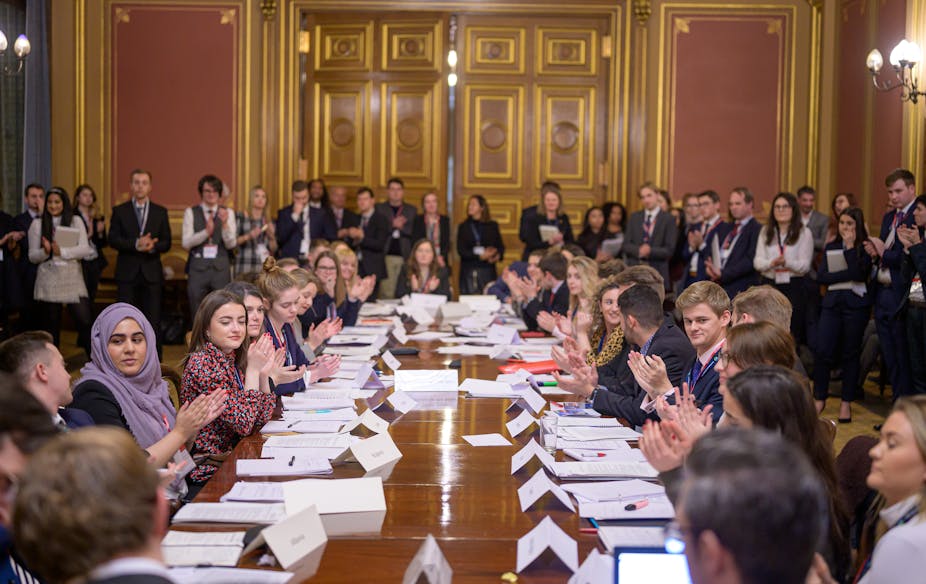When NATO leaders get together, their meetings tend to follow a familiar script and their gathering in a hotel north of London in early December was no different.
The presidents of France, Turkey and the US engaged in ill-tempered exchanges – casting Donald Trump, unusually, as NATO’s champion. Meanwhile, NATO’s unflappable secretary general, Jens Stoltenberg, did his best to talk up the alliance’s accomplishments: recognition of space as an operational domain, greater attention to China’s military modernisation, and “unprecedented” increases in defence spending.
The closing London Declaration, true to form, glossed over allied differences in favour of “solidarity, unity and cohesion”, noting concrete progress on counter-terrorism, burden-sharing and military readiness.
But if we left the serious business of diplomacy to students rather than politicians would they fare any better?
NATO: the real thing
Once the politicians leave town, it is flexibility and focus that matter. NATO has not survived for 70 years for nothing. Its “pragmatic functionalism” means the organisation can bend to the changing demands of its members and the fluid and sometimes sudden shifts in the international environment – be that the end of the Cold War, war in the Balkans, 9/11, the resurgence of Russian power and, conceivably, even the rise of China.
It is often forgotten that NATO has also played a role in disaster management. Its first such mission – flood relief in Belgium and the Netherlands – was as long ago as 1953. Since 1998, NATO has operated the Euro-Atlantic Disaster Response Coordination Centre (EADRCC). Albania, which suffered an earthquake at the end of November, has just requested assistance from that body.
Albania’s earthquake has not preoccupied NATO leaders much this week – but NATO’s agility in emergencies was tested to the limit in a “Model NATO” summit organised by the British International Studies Association and supported by NATO’s Public Diplomacy Division. In a day-long exercise on December 2, 2019, more than 90 students from 15 UK universities met at the Foreign and Commonwealth Office to role-play NATO’s response to a disaster of unprecedented scale and consequence.
A new model NATO
The participating students had been forewarned. In a briefing circulated some weeks earlier, they’d been alerted to the probability of significant seismic activity and the need to mobilise civil and military resources to cope with the consequences.
The crisis updates circulated on the day took the breath away: a massive earthquake in Turkey resulting in tens of thousands of fatalities, a landslip in the Canary Islands sending a tsunami racing across the Atlantic towards north America, and a massive volcanic eruption on the Italian island of Stromboli.
The students rose to the occasion. Representing all NATO’s 29 nations (plus incoming ally, North Macedonia), and working through two specialised NATO bodies – the Military Committee and the Civil Emergency Planning Committee – they agreed a detailed set of actions. Endorsed in a final declaration by NATO’s highest authority, the North Atlantic Council, that involved activating the EADRCC, partnering with the EU, the UN and the Red Cross, and mobilising national and joint NATO military assets for the delivery of humanitarian aid.

Inspiring future diplomats
Of course, all of this was fiction. But the exercise served an important educational purpose. Having been involved in Model NATO events for over a decade, I can think of no better educational tool than simulations and role play for motivating and enthusing students.
These are highly effective in replicating “real world” phenomena and so convey to students and instructors alike insights unobtainable in traditional classroom settings. Model UN is perhaps the best known example – but the European Union, the Arab League and the African Union are also frequently role-played.
Model NATO, meanwhile, has obtained a permanent presence in the educational calendar with simulations being run in Washington DC, Bologna, The Hague and elsewhere. The benefit of such events is not only educational. Preparation for, and involvement in, a model summit can inspire students to embark upon careers and projects in diplomacy, government, the charitable sector and the armed forces.
Politicians make the headlines, but it is the hard work and commitment of staffers, civil servants – and, in NATO’s case, the military – which keep international organisations on the road. Students become politicians but many more will join the ranks of these important professions.

